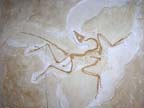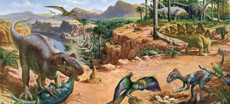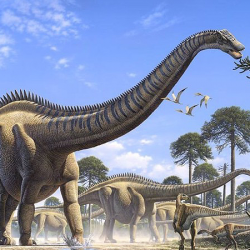 |
 |
 |
 |
 |
Produced
by the Population Genetics and Evolution class, Furman University |
||||
 |
 |
 |
 |
 |
Produced
by the Population Genetics and Evolution class, Furman University |
||||
 |
The
Jurassic |
 |
||
 |
The Jurassic Period was dominated by a variety of dinosaur lineages in the land, seas, and air. Marine environments were dominated by pliosaurs, crocodylomorphs, and the plesiosaurs. On land, the Jurassic was the time of the giant sauropods, like Diplodocus, Apatosaurus, Brachiosaurus, and Giraffatitan, to name only a few. Theropods were radiating into large and small forms. Large predators were represented by Allosaurus and Megalosaurus. Pterosaurs sill rules the air, but an interesting new radiation was occuring among small theropods. From small, bipedal, coelosaurid theropods like Compsognathus, a diverse clade of small, bipedal, feathered dinosaurs were radiating; represented by Archeopteryx (and the lineage that would lead to birds), and their relatives the Troodontids, Dromaeosaurs, and deinonychids. Many of the species in these taxa, like the troodontid, Anchiornis, predate Archaeopteryx and show that feathers probably evolved for ornamentation or thermoregulation before becoming useful for gliding and flight. Another group of endotherms were radiating, too. True mammals evolved, represented first by Hadrocodium and then by the Multituberculates - the most successful, abundant, and diverse group of Mesozoic mammals. |
 |
||
| Above: Supersaurus; Photo From: Dinosaur-facts.com Below, Jurassic scene, from: Correia Life Science | Above: Allosaurus and Stegosarus from: The Dallas Morning News Below: Plesiosaur, from: North Dakota Paleontology Home Page. |
|||
 |
 |
|||